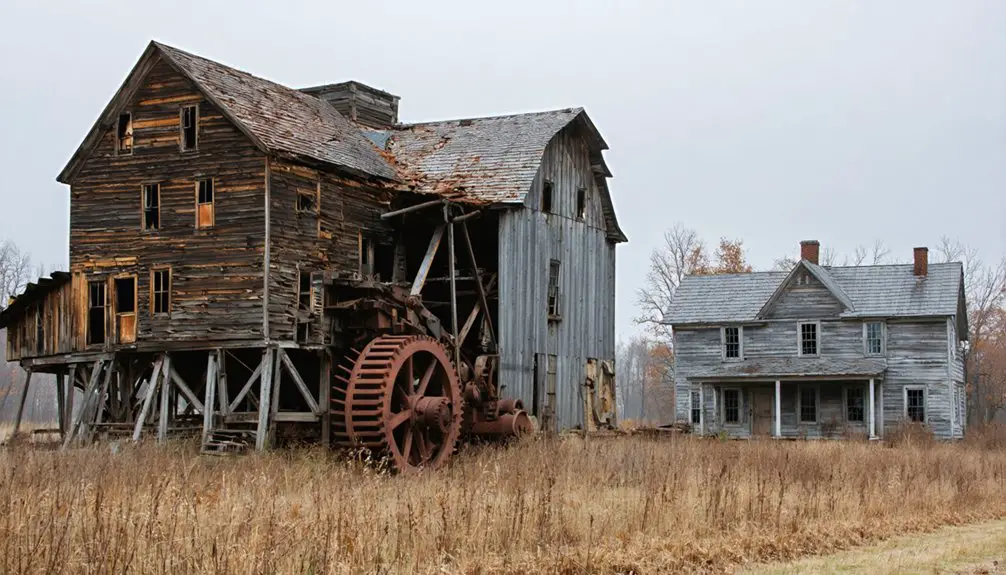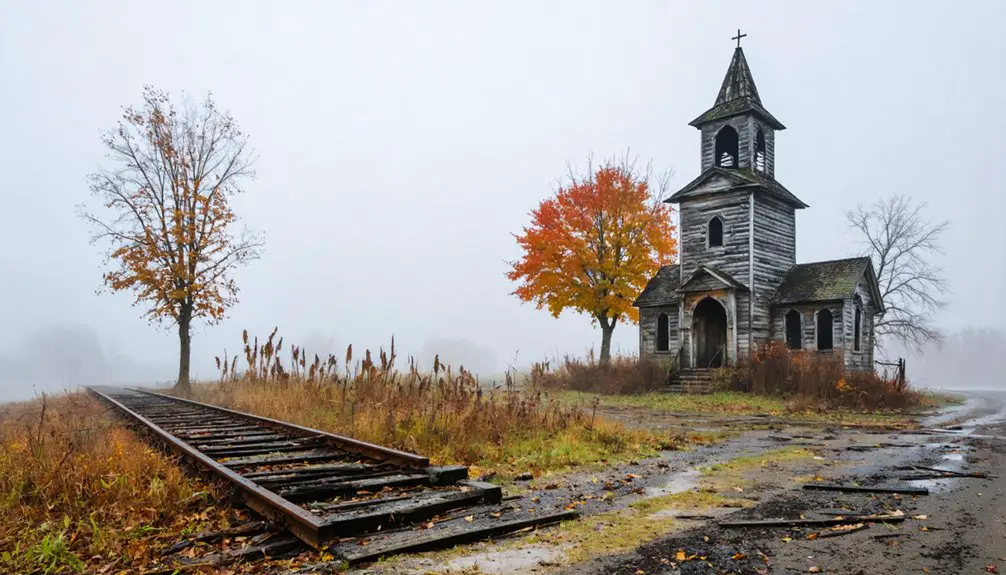You’ll find Emerson’s ghost town remnants along Michigan’s Tahquamenon River, where a bustling lumber community thrived from 1882 to 1912. The Chesbrough brothers transformed a small sawmill into a major operation, processing 125,000 board feet daily and building a complete company town. Though nature has reclaimed the site, you can explore the area’s rich history via the Emerson Trail and interpretive markers at Tahquamenon Falls State Park. The story of this forgotten lumber empire holds surprising secrets.
Key Takeaways
- Emerson was a lumber town established in 1882 near the Tahquamenon River that became a ghost town during the Great Depression.
- The Chesbrough Lumber Company operated a major sawmill processing 125,000 board feet of lumber daily until economic decline.
- No original buildings remain today, with the site marked by a Michigan State Historic Marker along M-123.
- The town relied on weekly supply ships from Sault Ste. Marie until 1891, facing harsh isolation during winter months.
- Visitors can explore the former town site via the Emerson Trail, with interpretative signage throughout Tahquamenon Falls State Park.
The Birth of a Lumber Town
While many lumber towns dotted Michigan’s landscape in the 1880s, Emerson emerged as a distinctive settlement when Kurt Emerson established his sawmill near the mouth of the Tahquamenon River.
The town wasn’t named after its founder, though – it honored Chris Emerson, an eccentric millionaire lumberman relative.
The economic impact of this new lumber town grew considerably when Chesbrough Lumber Company purchased the sawmill in 1884, expanding operations to process an impressive 125,000 board feet of lumber daily. Like other communities that would become educational institutions in Washington, D.C., Emerson started with humble beginnings.
Chesbrough Lumber Company transformed the local economy by expanding sawmill operations to process 125,000 board feet daily.
That same year, the community established its first post office with Fremont B. Chesbrough as postmaster.
The town developed into a self-sufficient community with homes and a school, though it remained largely isolated from outside supplies.
Early Days Along the Tahquamenon River
Before Emerson’s sawmill transformed the landscape, the Tahquamenon River held deep significance for indigenous peoples and early explorers. The region’s native explorations revealed thriving communities along this 89-mile blackwater river, with its distinctive amber waters draining an extensive 820-square-mile watershed. The river’s beauty and power were later immortalized in Longfellow’s Hiawatha.
In 1840, you’d have found state geologist Douglass Houghton canoeing to the Upper Falls, documenting signs of native life. That same year, William Austin Burt and his survey crew began their challenging work through the river’s wetlands.
They’d battle fierce mosquito swarms, relying on a primitive repellent made from charcoal and grease. Their perseverance through these harsh conditions laid the groundwork for the river’s future as a logging artery, though the river ecology they encountered would change dramatically in the decades to follow. The river’s distinctive color comes from its waters carrying significant amounts of tannin, giving it its characteristic brown hue.
Life in the Isolated Community
If you’d lived in Emerson during its early years, you’d have faced significant transportation challenges due to the absence of roads until 1891.
Your lifeline to the outside world would have been the weekly supply ships from Sault Ste. Marie, which operated only during navigation season.
You’d have needed to carefully stockpile provisions before winter set in, as the harsh weather and snow would isolate the community for months at a time.
The settlement was established in 1882 along the shores where the Tahquamenon River meets Lake Superior.
The community relied heavily on lumber and fishing industries until their eventual decline led to the town’s abandonment.
Daily Transportation Challenges
Since Emerson lacked roadways until 1891, residents faced significant daily transportation challenges that shaped every aspect of community life.
Your survival depended on maneuvering through these transportation struggles and adapting to harsh seasonal limitations. Without railways or major highways, you’d rely primarily on water routes and occasional horse-drawn transport to maintain your connection to the outside world. Like many Upper Peninsula towns, Emerson’s isolation made basic travel incredibly difficult. Supplies were delivered by boat every fortnight to sustain the remote community.
- You couldn’t count on year-round supply deliveries, as winter ice made Lake Superior impassable.
- Your medical emergencies became life-threatening due to limited access to healthcare facilities.
- Your children’s education suffered from weather-related travel disruptions.
- You’d need to stock up on essentials during transit season to survive winter isolation.
The community’s independence was constantly tested by these transportation constraints, ultimately contributing to its decline after 1912.
Community Supply Networks
The hardships of daily transportation in Emerson gave rise to an intricate web of community supply networks that kept the town alive.
You’d find weekly shipments arriving by boat from Sault Ste. Marie, bringing essential goods that were distributed through the general store and post office. Despite supply challenges, the town showed remarkable community resilience through mutual aid and resourcefulness.
You could see this adaptability in action as residents combined store-bought provisions with local hunting, fishing, and small-scale farming. Curtis Emerson initially found success in the area through his malt liquor business.
The Chesbrough Lumber Company’s sawmill, producing 125,000 board feet daily, anchored the local economy. When formal supplies ran short, you’d witness neighbors trading goods and services, while community workshops maintained tools to reduce dependency on external resources.
This interconnected system sustained Emerson until its eventual decline.
The Chesbrough Brothers’ Legacy
The Chesbrough Brothers’ ambitious vision transformed a small sawmill into one of Michigan’s most impressive lumber operations, featuring three steam engines capable of processing 125,000 board feet daily.
You’ll find their business acumen reflected in their strategic purchase of 93 million feet of prime cork pine in the 1870s, which eventually grew to 300 million feet harvested from the region.
The family’s entrepreneurial spirit extended beyond mere lumber production, as they built a complete company town with housing, stores, and essential services that supported hundreds of workers and their families. Their legacy in the community was further cemented through Fremont B. Chesbrough’s role as the first and only postmaster of Emerson from 1884 to 1914.
Mill Operations and Scale
Located at the mouth of the Tahquamenon River, Chesbrough Lumber Company‘s impressive mill operation showcased cutting-edge technology for its era, featuring three steam engines that could process up to 125,000 board feet of lumber daily.
The mill’s advanced technology and superior lumber quality attracted buyers from major markets like New York and Chicago.
You’ll find these remarkable features of the operation:
- Heavy industrial machinery, including boilers, transported by horse teams across challenging terrain
- Shift from wood-fired to coal-powered engines for improved efficiency
- Two-mile logging railroad connecting the mill to prime timber sources
- High-grade lumber production from large-diameter trees
After the original mill burned down, they relocated four miles south, where they built an extensive complex including bunkhouses, a company store, and essential community services, supporting over 100 residents at its peak.
Family Business and Vision
Founded by Alonzo Chesbrough and later run by his four sons, this family-operated lumber empire shaped the destiny of Michigan’s Tahquamenon region.
After Alonzo’s death in 1887, the business dynamics shifted as Abram Chesbrough stepped into the principal leadership role, working alongside his brothers Fremont, Frank, and Aaron.
Their business strategies proved revolutionary for the era. You’ll find their pioneering spirit in the purchase of 93 million feet of timber for $93,000, eventually harvesting 300 million feet of premium cork pine.
The brothers didn’t just build a business – they created a community. Their vision for Emerson included worker housing, stores, hotels, and camps, with dedicated homes for each brother’s family.
This commitment to community building remained central to their operations until the business’s gradual dissolution in the 1920s.
Peak Years of the Lumber Trade

During Michigan’s golden age of lumber, Saginaw Valley emerged as the state’s leading timber producer, with production values soaring from $1 million to $6 million between 1840 and 1860.
You would’ve witnessed unprecedented economic growth as steam-powered sawmills revolutionized lumber production, operating twelve hours daily and transforming the region’s industry.
Here’s what made the lumber trade boom so remarkable:
The extraordinary lumber boom transformed Michigan’s economy, turning wilderness into wealth through unmatched timber production and technological innovation.
- Michigan achieved peak lumber production of 5.5 billion board feet in 1889-1890
- The Saginaw Valley alone generated $7 million in annual lumber value by 1869
- Rivers like the Saginaw enabled efficient log transportation from forest to mill
- Michigan maintained its position as America’s leading lumber producer for three decades
This explosive growth laid the foundation for the region’s prosperity, with lumber shipped to major urban centers across the Northeast and Midwest.
Daily Life in Frontier Emerson
Life in frontier Emerson revolved around the tireless work of its resilient settlers, who built their community from locally sourced timber and basic materials.
You’d find simple one-room cabins with lofts scattered near water sources, where families tended small plots growing corn and potatoes. Frontier cuisine relied heavily on wild game, preserved foods, and home-grown vegetables.
Daily routines centered on survival and mutual support. While men worked in logging or farming, women managed households, preserving food and crafting essential items.
The community gathered for seasonal gatherings like barn dances and church meetings, sharing news and strengthening bonds. At the one-room schoolhouse, children learned basic subjects while absorbing practical skills from their elders.
Despite challenges of harsh winters and isolation, settlers adapted through strong community ties and self-reliance.
The Decline of the Timber Industry
While Emerson’s early prosperity hinged on its booming timber trade, the late 19th century brought devastating changes to the town’s primary industry.
Without timber sustainability practices, the region’s rich pine forests were rapidly depleted, leaving the community struggling to maintain its economic resilience.
- Clear-cutting between 1840-1900 exhausted local white pine resources, forcing major operators like Chesbrough Lumber Co. to cease operations.
- Steam-powered mills increased production but accelerated forest depletion.
- Railroad expansion drew timber operations westward, leaving smaller towns like Emerson at a competitive disadvantage.
- The Great Depression’s reduced lumber demand dealt the final blow, leading to widespread unemployment.
The town’s population dwindled as mills closed, transforming this once-thriving lumber community into a ghost town, with abandoned homes and shuttered businesses marking the end of Emerson’s timber era.
From Bustling Mill Town to Ghost Town
As prosperity flowed through Emerson in the 1880s and 1890s, few could have predicted the town’s swift transformation from a bustling lumber center to a vanished settlement.
When the Chesbrough Lumber Company’s mill shut down in 1912, you’d have witnessed the town’s rapid unraveling as the lumber economics that once sustained it collapsed.
While some residents tried to adapt by turning to commercial fishing, the town’s decline proved unstoppable.
By 1927, local children were attending school in Paradise, and by 1939, only 25 residents remained.
With just 25 souls remaining by 1939, Emerson’s children had long since migrated to Paradise for their schooling.
The early 1940s marked Emerson’s final chapter, as buildings were sold and removed.
Today, ghost town exploration reveals only a historical marker where this once-thriving community stood, a stark reminder of how quickly fortunes can change when natural resources run dry.
Traces of History in Modern Times
While you won’t find any original buildings standing in Emerson today, you’ll discover a Michigan State Historic Marker along M-123 that marks this once-thriving lumber community near the mouth of the Tahquamenon River.
You can access the former town site by following the Emerson Trail, which begins at the historic marker and leads to where the community once stood along Lake Superior’s shores.
The area’s continued presence on modern maps and the preserved hiking trail serve as lasting connections to Emerson’s significant role in Michigan’s lumber heritage.
Physical Remnants Today
Although Emerson once bustled with lumber industry activity, today’s visitors will find few physical traces of the former Michigan town. The site has undergone extensive natural reclamation, with forest regrowth dominating where remnant structures once stood.
You’ll find the area largely reverted to wilderness within Tahquamenon Falls State Park’s boundaries.
- No standing buildings remain, and concrete foundations have largely disappeared
- A Michigan State Historic marker from 1980 stands along M-123 near the Emerson Trail entrance
- The original Emerson Trail exists as an undeveloped footpath to the former town center
- You can spot scattered debris from lumber and fishing operations, though these remnants are minimal
Today, the wild shoreline of Lake Superior and dense woods have reclaimed what was once an industrial landscape, preserving only the geographic memory of Emerson’s past.
Historical Site Access Points
Three main access points guide modern visitors to Emerson’s historic location within Tahquamenon Falls State Park‘s Rivermouth Unit.
You’ll find the site most accessible by following M-123 highway through Michigan’s Upper Peninsula, which replaced the original 1891 roadway. The park’s maintained trail system offers a second approach, letting you explore the river mouth area where the settlement once thrived.
For a unique historical perspective, you can trace the water route that early settlers used, as the Tahquamenon River meets Lake Superior at this point.
While no original structures remain, interpretative signage and historical markers throughout the park help you understand Emerson’s significance as a former lumber and shipping hub.
The site’s best visiting times run from late spring through early fall.
Exploring Emerson’s Historic Site Today
As you explore Emerson’s historic site today, you’ll find a landscape that’s returned largely to its natural state, with minimal visible evidence of the once-bustling lumber town.
Historical markers guide your journey through this ghost town, offering glimpses into its fascinating past at the mouth of the Tahquamenon River.
To make the most of your visit:
Make your journey count by planning ahead and timing your visit thoughtfully to experience all this historic site offers.
- Access the site via local roads, though you’ll need to hike or use off-road transportation
- Look for the historical marker that pinpoints the town’s original location
- Visit during navigation season when weather conditions are most favorable
- Combine your exploration with nearby historic sites like Shelldrake’s remaining cabins
The site’s untamed environment lets you experience the raw beauty that first drew settlers here, while imagining the vibrant logging community that once called this place home.
Frequently Asked Questions
Were Any Notable Crimes or Murders Reported in Emerson During Its Existence?
You won’t find any documented historical crimes or unsolved mysteries from this community’s active years – records and local histories show no evidence of notable criminal activity during its existence.
What Happened to the Original Sawmill Equipment After the Town’s Abandonment?
You’ll find no clear records of the sawmill equipment’s fate after the town’s abandonment. It was likely dismantled and scrapped in 1912 when operations ceased and resources were depleted.
Did Any Famous People Ever Visit or Stay in Emerson?
You won’t find records of famous visitors to this location during its heyday or afterward. While lumber industry figures frequented the area, none achieved broader historical significance beyond local business circles.
What Native American Tribes Lived in the Area Before Emerson’s Establishment?
You’d find the Potawatomi, Ojibwe, and Ottawa tribes as primary inhabitants, with strong Ojibwe influence throughout the region’s tribal settlements. The Wyandot people also maintained villages in the area.
Were There Any Churches or Religious Institutions in the Town?
You won’t find records of formal churches in town, though religious influence likely existed. Community gatherings, including possible worship services, took place in private homes rather than dedicated church buildings.
References
- https://en.wikipedia.org/wiki/Emerson
- https://michigansup.fandom.com/wiki/Emerson
- https://travelswithabandon.com/2018/08/22/adventure-8-ozark-emerson-shelldrake/
- https://www.portersquarebooks.com/book/9780934884020
- https://www.ghosttowns.com/states/mi/emerson.html
- https://www.radioresultsnetwork.com/2019/10/18/dnr-recalls-history-of-tahquamenon-falls-state-park/
- https://www.hmdb.org/m.asp?m=213408
- https://www.michigandnr.com/publications/pdfs/ArcGISOnline/StoryMaps/mhc_historical_markers/pdfs/MHC171979017.pdf
- https://puresaginaw.com/the-halls-of-montezuma/
- https://www.michigan.gov/-/media/Project/Websites/dnr/Documents/Education/visitorcenters/TFSP_Visitor_2014_WEB.pdf?rev=1a1f9e921084491c88d917d5aa498fe4


